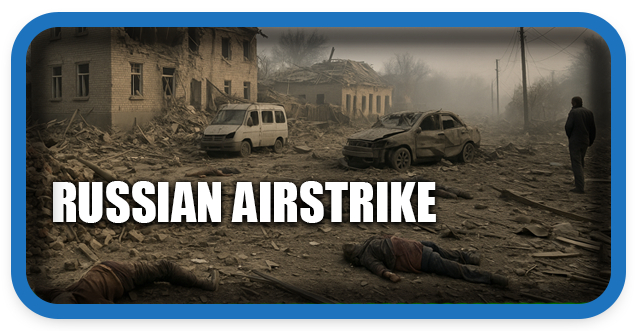⏲️ Estimated reading time: 11 min
A Russian airstrike on the village of Yarova in Ukraine’s Donetsk region killed more than 20 civilians and injured many others, according to President Volodymyr Zelensky. The attack struck people queued for pension payments, renewing calls for tougher global sanctions and accountability.
What Happened in Yarova and Why It Matters
On a grim day for eastern Ukraine, a Russian airstrike tore through the small village of Yarova, in Donetsk, killing more than 20 civilians and injuring dozens who had lined up to collect pensions. Ukrainian authorities say the blast was consistent with a glide bomb an aerial munition increasingly used to strike fixed targets from standoff range. The timing and location made the attack especially devastating: ordinary people, many older people, were gathered in a predictable queue at a mobile site used to distribute cash pensions.
President Volodymyr Zelensky condemned the strike as “brutal,” arguing that it exemplifies a pattern of civilian targeting rather than battlefield engagement. Regional officials labeled it terrorism, while Kyiv reiterated pleas for tougher sanctions and expedited air-defense support. The attack underscores several themes that have defined this war: the vulnerability of civilians, the growing lethality of standoff air-delivered munitions, and the political stakes of sustaining international support.
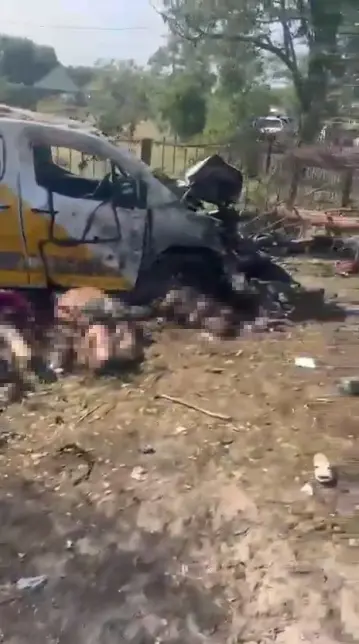
This incident is not an isolated tragedy. It sits in a wider context of escalated bombardments along and behind the front, where the line between “rear” and “frontline” has blurred. Yarova, although behind active positions, remains within reach of modern Russian air-delivered weapons. For Ukraine, the strategic calculus is stark: without robust, layered air defenses and continued resupply, similar strikes may remain possible against civilian nodes like post offices, markets, and power infrastructure.
The Setting: Donetsk, the Front, and the Civilian Queue
Yarova is one of countless villages scattered across Donetsk oblast, an area long at the heart of fighting. While frontlines shift and ebb, life does not pause people still need pensions, medication, food, and social support. Mobile and temporary service points, including pension payout spots, have become routine in areas where permanent offices have closed or been damaged.
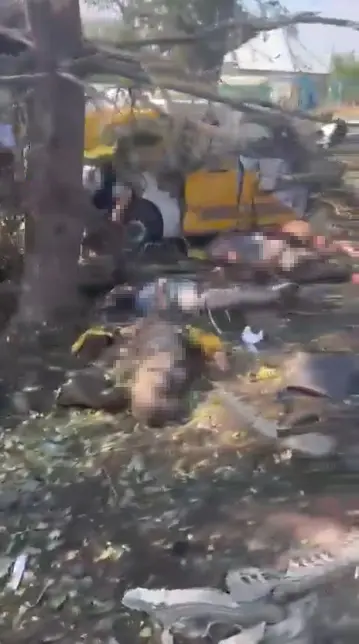
That necessary predictability creates risk. A queue is a visible, static congregation an easy-to-spot target for both artillery and air-delivered munitions. Even if the precise intent can be debated, hitting such a location during a known payout window creates the foreseeable likelihood of mass civilian casualties. Under the laws of armed conflict, predictability increases an attacker’s obligation to verify targets and avoid civilian harm.
The human impact is immediate and multigenerational. Many pensioners serve as core pillars in their families helping care for grandchildren or providing the only stable income amid wartime disruption. The loss of dozens of lives in moments ripples through hundreds of loved ones: families lose caretakers, children lose guardians, and communities lose institutional memory.
Weapon Focus: What Is a Glide Bomb and Why Is It So Lethal?
A glide bomb begins as a conventional aerial bomb that has been fitted with aerodynamic kits and, in many cases, guidance packages that improve range and accuracy. The key advantage for the attacker is standoff: aircraft can release the bomb tens of kilometers away, reducing exposure to air defenses near the target.
Why they matter here:
- Standoff Delivery: Pilots can release outside of the densest air-defense envelope, enabling more frequent use near populated areas.
- High Explosive Yield: Even a single glide bomb can generate devastating blast and fragmentation effects.
- Targeting Predictability: If attackers possess basic intelligence on routines (queues, distribution points, shift changes), the munition’s accuracy makes it inherently dangerous for civilians.
- Infrastructure Damage: Beyond immediate casualties, these weapons can destroy the very facilities that sustain civilian life payout centers, clinics, warehouses.
For defenders, neutralizing glide-bomb campaigns requires integrated air defenses (IADS), improved early warning, electronic warfare, and, increasingly, the political will from partners to supply interceptors and long-range systems. Each successful intercept saves lives; each gap can enable tragedies like Yarova.
Legal and Moral Dimensions: Distinction, Proportionality, and Precautions
International humanitarian law (IHL) rests on three pillars relevant to this case:
- Distinction: Parties must distinguish at all times between combatants and civilians. Striking a known civilian queue infringes heavily on this principle unless there is a legitimate military target present and the civilians are incidental and even then, the bar for proof is high.
- Proportionality: Even if a military objective is present, the expected civilian harm must not be excessive in relation to the anticipated military advantage. A pension queue is a strong marker of civilian presence; any strike there risks violating proportionality unless extraordinary, well-substantiated justification exists.
- Precautions: Attackers must take all feasible precautions to minimize civilian harm, including choosing means and methods less likely to cause incidental casualties, adjusting timing, or abstaining entirely.
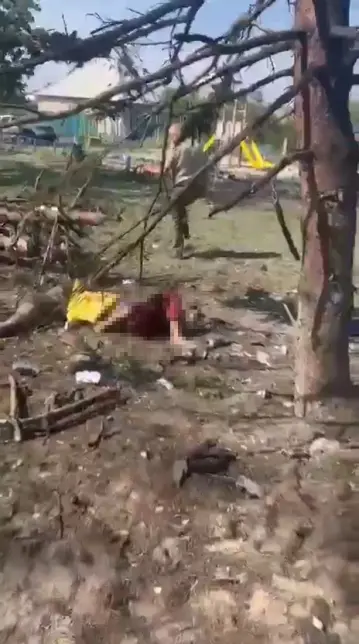
In public rhetoric, “terrorism” is often used to describe strikes that appear designed to spread fear among civilians. Legally, accountability would hinge on evidence: targeting orders, ISR (intelligence, surveillance, reconnaissance) records, weapon fragments, geolocation, and timing. If future investigations corroborate that civilians were the intended or recklessly disregarded victims, criminal liability could attach under domestic or international courts.
The Political Aftershock: Sanctions, Support, and Strategy
Zelensky quickly called for tougher global sanctions. What might that entail?
- Energy Measures: Tighter enforcement on oil price caps and shipping, reducing Russia’s hydrocarbon revenues.
- Dual-Use Technology Controls: Plugging gaps that allow advanced components to reach Russia through intermediaries.
- Financial Restrictions: Broader limits on banking, insurance, and reinsurance that enable war-economy transactions.
- Secondary Sanctions: Targeting entities in third countries that facilitate evasion.
- Defense Aid Linkage: Pairing sanctions with expedited air-defense and counter-strike capabilities to deter repeat attacks.
Sanctions are slow-burn tools. Their effectiveness grows with breadth (how many countries participate), depth (how comprehensive the restrictions), and enforcement (how seriously breaches are punished). Following high-casualty incidents, democratic governments often face public pressure to act shaping agendas in the EU, the U.S., G7, and the broader G20.
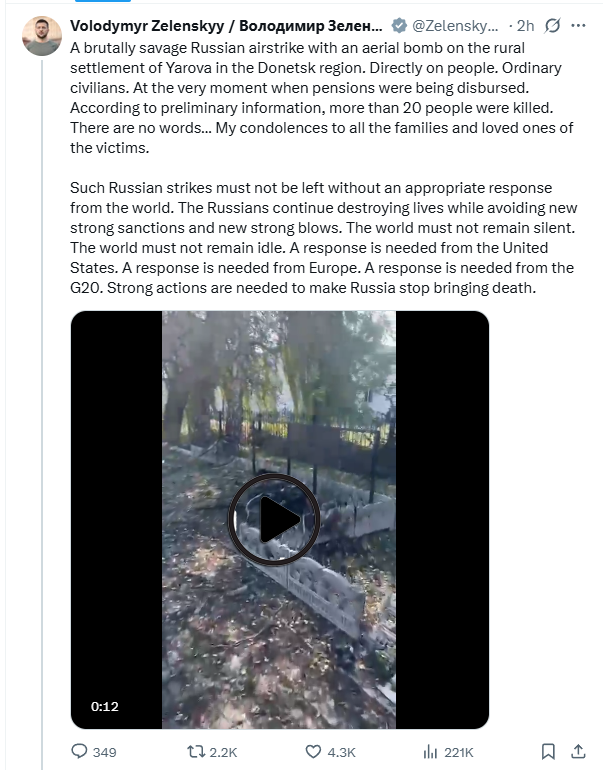
The Operational Angle: Why Civilian Nodes Are at Risk
From an operational perspective, Russia has incentives to target what Ukraine must protect:
- Public Services: Pensions, hospitals, evacuation hubs strikes here erode trust and force resource diversion.
- Energy and Logistics: Power substations, rail nodes, bridges disrupt the sinews that move troops and supply civilians.
- Psychological Pressure: Civilian fear can drive displacement, strain social systems, and sap national resilience.
Ukraine counters by dispersing services, tightening schedules, improving concealment, and expanding air-defense umbrellas. But dispersal has trade-offs: more sites to protect, more coordination overhead, and a heavier burden on overstretched staff. Without greater interceptor stocks and radar coverage, the defender’s dilemma persists: protect the front or shield the rear?
Humanitarian Impact: Immediate Needs After Mass-Casualty Strikes
When a strike like Yarova happens, the first 24–72 hours set the tone for recovery:
- Medical Surge: Triage, trauma surgery, blood supply, and post-operative care for blast injuries.
- Psychosocial Support: Mental health care for survivors, witnesses, and responders.
- Family Tracing: Reuniting families, identifying the dead, and managing dignified burials.
- Cash Assistance: Replacing lost pensions or documents and ensuring continuity of livelihoods.
- Shelter and Repairs: Boarding up damaged buildings, clearing debris, restoring essential services.
As the weeks pass, attention shifts to resilience building: hardening payout sites, revising schedules, rehearsing shelter-in-place drills, and expanding public warning systems (sirens, mobile alerts). Even modest improvements marked blast walls, overhead cover, staggered queues can save lives.
OSINT and Evidence: How Truth Is Established
In modern conflicts, the truth emerges through a mosaic of sources:
- Geolocation: Matching visual clues (storefronts, road signs, terrain) to satellite imagery.
- Chronolocation: Using shadows, weather data, and metadata to verify timing.
- Fragment Analysis: Identifying weapon types via debris and damage signatures.
- Pattern-of-Life: Assessing whether civilians typically gather at a location at certain times.
- Witness Testimony: Cross-checking accounts to rule out fabrication or coercion.
For Yarova, the presence of a pension distribution point is a key data point. If investigators document that queues form predictably at specific hours and that no nearby military target existed, the case for unlawful targeting strengthens. Transparent investigations by Ukrainian authorities, international observers, and independent NGOs help build a credible record for courts and history.
Air Defense and the Path Forward
Ukraine’s most urgent material need in this domain is layered air defense:
- Detection: Early warning radar to cue interceptors and public alerts.
- Intercept: Systems capable of engaging aircraft and incoming glide bombs.
- Electronic Warfare: Degrading guidance links where applicable.
- Counter-Air: Pushing launch platforms further back, reducing opportunities to release standoff munitions.
- Hardened Civil Sites: Passive measures sandbags, modular barriers, reinforced roofs especially around predictable queues.
Every layer matters. Even if not every munition can be intercepted, increasing the attacker’s cost and lowering their success rate can shift behavior. Over time, such defensive adaptations, coupled with diplomatic and economic pressure, can reduce the frequency and lethality of strikes like Yarova.
International Response: What to Watch Next
- Statements and Condemnations: Expect rapid condemnations from allied governments and multilateral bodies. The phrasing “war crime,” “terror,” “indiscriminate” signals legal and diplomatic intent.
- Sanctions Packages: Watch for new measures targeting revenue streams, logistics chokepoints, and technology flows.
- Aid Announcements: Additional air-defense systems, interceptors, and civil protection aid (mobile clinics, shelters).
- Investigations: Open-source and official probes that compile admissible evidence for future prosecutions.
- Civic Mobilization: Fundraisers, diaspora advocacy, and international media attention that keep civilian protection on the agenda.
The tempo of these responses matters. Swift, tangible steps communicate deterrence. Delays can embolden further attacks or normalize civilian harm.
Voices From the Ground: Why Language Matters
Phrases like “brutally” resonate because they cut through euphemisms. Mass-casualty incidents can become numbing statistics unless language conveys human stakes. For editors and policymakers alike, precise words serve a dual purpose: to capture the horror and to frame legal, moral, and political responsibility. Yet precision also demands restraint. Good reporting separates confirmed facts from inference, flags uncertainties, and avoids sensationalism that could obscure accountability.
Practical Guidance for Civilians in At-Risk Areas
While responsibility lies with attackers to avoid civilian harm, communities can take steps that reduce exposure:
- Staggered Arrival: Avoid peak queue times; rotate family members to shorten individual exposure.
- Cover and Concealment: Identify nearby hard-cover spots (basements, reinforced rooms).
- Alert Apps and Sirens: Keep phones charged; monitor air alerts; rehearse “drop and cover” routes.
- Documentation: Carry essential papers in waterproof pouches; maintain duplicates elsewhere.
- First Aid Basics: Small tourniquets, pressure dressings, and knowledge of bleeding control save lives.
- Community Watch: Volunteers can observe surroundings, share updates, and assist the older people in rapid movement.
These measures cannot eliminate risk, but they can transform outcomes in seconds that count.
Accountability and Memory: From Evidence to Justice
Justice in war is often slow, but documentation today shapes prosecutions tomorrow. Each verified case builds the legal scaffolding for future tribunals or domestic courts. Families of the victims deserve not only material support but the dignity of a truthful record. Memorials, community testimonies, and investigative archives ensure that names are not lost to statistics.
In parallel, policy must keep pace. If glide bombs and other standoff weapons are a persistent threat to civilians, partner nations face a moral test: will they align export controls, sanctions, and aid to restrict those threats and strengthen defenses where they are most needed?
Conclusion
The Yarova airstrike is a chilling snapshot of a broader reality: modern standoff weapons enable deadly precision against predictable civilian gatherings. More than 20 lives ended in moments that should have been ordinary standing in line for a pension. The moral clarity here is piercing. Whatever the combatants’ claims, international humanitarian law demands distinction, proportionality, and precautions. When these are breached, the consequences are not abstract they are grandmothers, grandfathers, neighbors, and friends who will never come home.
President Zelensky’s call for tougher measures invites the world to decide whether outrage becomes action. That action spans three fronts: sanctions that meaningfully constrict the war economy, aid that closes gaps in Ukraine’s air defenses and civil protection, and accountability that preserves truth for courts and history. At the community level, resilience measures from staggered queues to reinforced payout points can save lives even while larger systems are built.
If Yarova is to stand for anything beyond tragedy, let it stand for a renewed commitment to civilian protection and the will to match words with deeds.
🔔 For more tutorials like this, consider subscribing to our blog.
📩 Do you have questions or suggestions? Leave a comment or contact us!
🏷️ Tags: Ukraine, Russia, Donetsk, Yarova, Volodymyr Zelensky, Glide Bomb, War Crimes, Sanctions, G20, Eastern Ukraine
📢 Hashtags: #Ukraine #Donetsk #Yarova #Zelensky #Russia #WarCrimes #Sanctions #GlideBomb #EasternUkraine #BreakingNews
Only logged-in users can submit reports.
Discover more from HelpZone
Subscribe to get the latest posts sent to your email.

